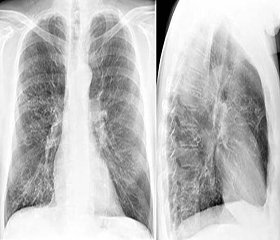Журнал «Здоровье ребенка» 2 (61) 2015
Вернуться к номеру
Influence persistent intracellular infections on processes airway remodeling in asthma in children.
Авторы: Chernyshova O. Ye.
Рубрики: Педиатрия/Неонатология
Разделы: Клинические исследования
Версия для печати
The article presents information about influence persistent intracellular infections on processes airway remodeling in asthma in children.
As a result of inflammation, which develops in bronchial asthma under the influence of specific and non-specific factors occur morphological and functional changes in the structures of the bronchi. According to modern ideas, remodeling develops early enough in the first year of persistent allergic inflammation. Deep trophy disorders characterized by hypertrophy of smooth muscle, increased formation of new blood vessels, accompanied stagnation hyperplasia and metaplasia of the epithelial goblet cells and submucosal glands increase collagen deposition in the lamina reticularis (the basal membrane seal), resulting in rearrangement (remodeling) bronchial wall.
We studied the levels of various neurotransmitters bronchial remodeling in the serum of children with asthma living cytomegalovirus, herpes simplex virus of I / II types, Epstein-Barr virus, Mycoplasma pneumoniae Chlamydophila pneumoniae, with the active and latent course of infection, as well as uninfected patients intracellular pathogens. In particular, the enzyme levels were determined metalloproteinase 9 (MMP-9), a specific tissue inhibitor of MMP-9 - TIMP-1, transforming growth factor-β (TGF-β), endothelin-1, autoantibodies to collagen type III.
The study revealed that the level of endopeptidase enzyme MMP-9 in the serum of children, both infected and non-infected with intracellular pathogens by more than a factor of 2-2.5 was higher than in the group of healthy children. Metalloproteinases are able to hydrolyze all components of the extracellular matrix: collagen, procollagen, elastin, fibronectin. Under physiological conditions, metalloproteinases are secreted in small quantities and are governed by specific tissue inhibitors of metalloproteinases (TIMP). Inhibition of MMP-9 occurs under the action of tissue inhibitor of type I - TIMP-1.
The study revealed that the level of tissue inhibitor of metalloproteinases TIMP-1 in the serum of children with asthma, as infected and uninfected intracellular pathogens, more than 7 times was higher than in the group of healthy children. With active current infection in patients in group I TIMP-1 level was higher than during latent infection.
In the group of asthmatic children infected with intracellular pathogens, the level of TGFβ-1 is almost 5 times higher than was healthy children. In the group of children, uninfected intracellular infections, levels of this cytokine was 2 times higher than healthy children.
Thus, elevated levels of TGFβ-1 associated with progression of fibrosis and airway remodeling in patients with bronchial asthma in our patients. Infection of intracellular infections exacerbates this process, especially in the case of an active course of the infection.
It was found that the level of endothelin-1 was significantly higher in the blood serum of children suffering from bronchial asthma, both infected and uninfected intracellular infections compared with healthy children. With the active and latent infections during intracellular persistent indicators of endothelin-1 were almost identical.
In a survey of children with asthma found that children in the intervention group and the comparison group showed a statistically significant increase in the level of autoantibodies to collagen type III compared with a group of healthy children. Enhancement of autoantibodies to collagen type III in bronchial asthma in children, occurring against the backdrop of various currents of infection caused by intracellular pathogens and without infection, evidence of disorganization of collagen structures, especially during the active infection.
Thus, as a result of studies have provided evidence of the impact of persistent intracellular infections, such as cytomegalovirus, herpes simplex virus of I / II types, Epstein-Barr virus, Mycoplasma pneumoniae and Chlamydophila pneumoniae, especially when their active current, on airway remodeling in asthma, which causes the need for treatment along with the basal disease, etiopathogenetic treatment to reduce the airway remodeling process, reducing the severity of the disease and to reduce disability.

